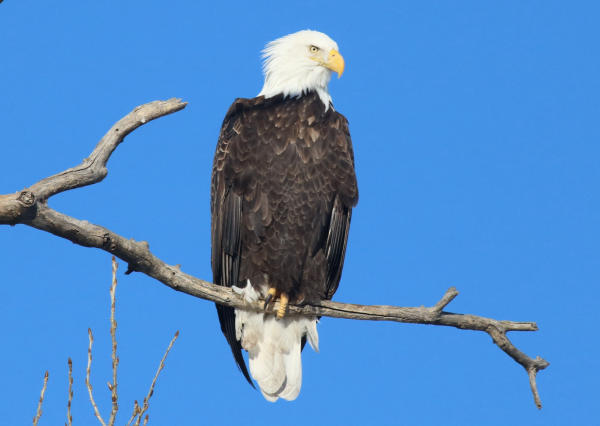
Today we see many more immature Bald Eagles. This species does not develop adult plumage until their fourth or fifth year.

It seems all Americans are aware of seeing more Bald Eagles today, compared to earlier decades.
|
Did the Endangered Species Act help prevent the extinction of our national bird, the Bald Eagle? It’s hard to know for sure, but there can be little doubt that it played a positive role in bringing Bald Eagles back from their previously endangered status in the 1970s.
When the Bald Eagle was named our national symbol in1782, there were probably more than 100,000 pairs in North America. The eagles’ decline started soon thereafter as populations of waterfowl and shorebirds upon which they preyed plummeted, its habitats were destroyed, and they were aggressively shot as vermin and trophies.
The Bald Eagle Protection Act of 1940 probably helped, but the use of insecticides like DDT, DDE and Dieldren dealt the species a terrible blow after World War II. As birds of prey at the top of the food chain, Bald Eagles ate affected fish and increased levels of the chemicals that resulted in infertile eggs and thinned eggshells that caused eggs to break and reduced reproductive rates in our national bird. Bald Eagles were also poisoned by eating lead shot in animal carcasses that contained lead bullets or shotgun pellets, and from pollution that affected fish and other prey. In 1963, there were probably only 400 to 500 pairs in the lower 48 United States.
In 1978, Bald Eagles were added to the Endangered Species List, paving the way for government agencies and conservation groups to accelerate protection efforts, law enforcement, nest site protection and captive breeding. On June 28, 2007, the Bald Eagle was officially removed from the Endangered Species Act (ESA), less than 30 years after the ESA protection was afforded. By that time, there were an estimated 10,000 nesting pairs in the contiguous 48 states.
The recent announcement that the current administration will consider revisions to the Endangered Species Act enrages conservationists and thrills some businesses. Most conservationists would agree that we’ve learned a lot since the Endangered Species Act was signed into law by President Richard Nixon in 1973, and that there are ways to improve it. But will “modernizing” the ESA reduce the effectiveness of some of its key tenets, as feared by many in the natural resources community?
During the next several months The Birding Wire will feature stories on the Endangered Species Act that are insightful and thought-provoking. Ultimately, it will be the will of the American people that determines what will happen to the Endangered Species Act, and we encourage readers to contact their representatives and let your opinions be counted.
Article by Peter Stangel
Photographs by Paul Konrad
An interesting and informative story written by Sarah Gold for the online magazine Slate is available at http://www.slate.com/articles/health_and_science/science/2017/05/the_endangered_species_act_wasn_t_meant_to_save_the_animals.html